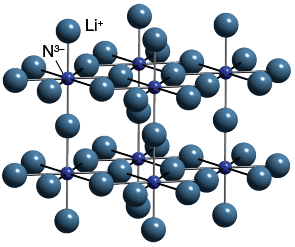Formula Li3N Density 1.27 g/cm³ | Molar mass 34.83 g/mol Appearance red, purple solid | |
 | ||
Related compounds | ||
Alkali metals 11 lithium nitride
Lithium nitride is a compound with the formula Li3N. It is the only stable alkali metal nitride. The solid is a red or purple color and has a high melting point.
Contents
- Alkali metals 11 lithium nitride
- This is how the ionic bond forms in lithium nitride li3n
- Preparation and handling
- Structure and properties
- References
This is how the ionic bond forms in lithium nitride li3n
Preparation and handling
Lithium nitride is prepared by direct combination of elemental lithium with nitrogen gas:
6 Li + N2 → 2 Li3NInstead of burning lithium metal in an atmosphere of nitrogen, a solution of lithium in liquid sodium metal can be treated with N2. Lithium nitride reacts violently with water to produce ammonia:
Li3N + 3 H2O → 3 LiOH + NH3Structure and properties
alpha-Li3N (stable at room temperature and pressure) has an unusual crystal structure that consists of two types of layers, one sheet has the composition Li2N− contains 6-coordinate Li centers and the other sheet consists only of lithium cations. Two other forms are known: beta-Lithium nitride, formed from the alpha phase at 4,200 bars (4,100 atm) has the Sodium arsenide (Na3As) structure; gamma-Lithium nitride (same structure as Li3Bi) forms from the beta form at 35 to 45 gigapascals (350,000 to 440,000 atm).
Lithium nitride shows ionic conductivity for Li+, with a value of c. 2x10−4Ω−1cm−1, and an (intracrystal) activation energy of c. 0.26eV (c.24 kJ/mol). Hydrogen doping increases conductivity, whilst doping with metal ions (Al, Cu, Mg) reduces it. The activation energy for lithium transfer across Lithium nitride crystals (intercrystalline) has been determined to be higher at c. 68.5 kJ/mol. The alpha form is a semiconductor with band gap of c. 2.1eV.
Reaction with hydrogen at under 300 °C (0.5MPa pressure) produces Lithium hydride and Lithium amide.
Lithium nitride has been investigated as a storage medium for hydrogen gas, as the reaction is reversible at 270 °C. Up to 11.5% by weight absorption of hydrogen has been achieved.
